目录
1. 概要
Spring Security是一个用于在Java应用程序中实现 身份验证 和 访问控制 的强大框架。它可以轻松地集成到任何基于Spring的应用程序中,提供了一套丰富的功能来保护应用程序的安全性。
2. spring security原理
对于servlet三大组件,spring security位于Filter过滤链中,SpringSecurity 本质就是一个过滤器链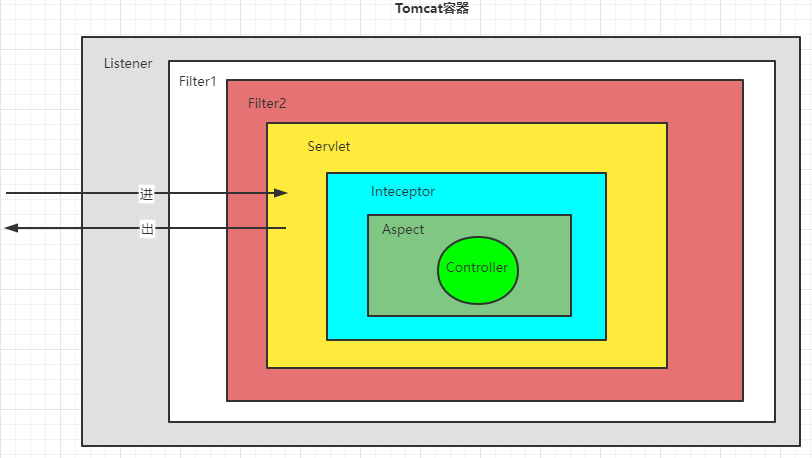
SpringSecurity 采用的是责任链的设计模式,它有一条很长的过滤器链
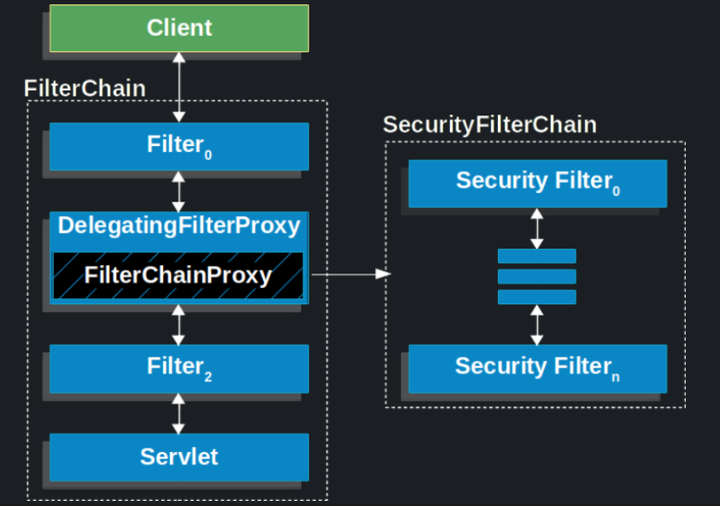
2.1 DelegatingFilterProxy
Spring 提供了一个 DelegatingFilterProxy 代理类,DelegatingFilterProxy 实现了Filter,因此它可以被注入到 FilterChain(过滤器链)中,同时,当请求到来时,它会把请求转发到Spring容器 中实现了Filter接口的 Bean 实体,DelegatingFilterProxy会从ApplicationContext中获取FilterBean 实体,然后将请求转发给到它,所以 DelegatingFilterProxy 桥接了 Servlet容器 和 Spring容器。
2.2 FilterChainProxy
DelegatingFilterProxy从Spring容器中获取得到的就是FilterChainProxy实体,而FilterChainProxy也是一个代理类,它最终会将请求转发到 Spring Security 提供的 SecurityFilterChain 中,FilterChainProxy就是 Spring Security 真正的入口起始点
2.3 SecurityFilterChain
SecurityFilterChain作用其实跟Servlet的FilterChain一样,同样维护了很多Filters,这些Filters 是由Spring Security提供的,每个 Security Filter 都有不同的职能,比如登录认证、CSRF防御…
2.4 Spring Security 作用机制
- 注册标准Filter:首先,会自动注入一个DelegatingFilterProxy到 Servlet 的FilterChain中。
- 请求转发到 Spring Security:当请求到来时,DelegatingFilterProxy就会自动在 Spring容器 中搜索名称为springSecurityFilterChain的Filter实体,其实际类型为FilterChainProxy。DelegatingFilterProxy最终会将请求转发给到FilterChainProxy。
- 找到匹配请求处理的SecurityFilterChain:FilterChainProxy内部维护了一系列SecurityFilterChains,他会依据请求内容找到对应处理该请求的SecurityFilterChain。
- 请求处理:找到能处理请求的第一个SecurityFilterChain后,就会遍历该SecurityFilterChain内部维护的一系列Filters,依次让这些 Security Filter 处理该请求,完成认证、授权等功能。
3.Spring Security快速入门
步骤1:添加Spring Security依赖
在你的Spring Boot项目的pom.xml文件中,添加Spring Security的依赖:<dependency> <groupId>org.springframework.boot</groupId> <artifactId>spring-boot-starter-security</artifactId> </dependency>步骤2:写一个简单地hello接口:
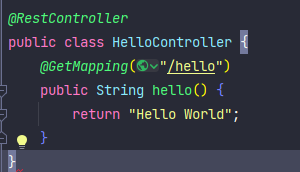
步骤3:浏览器访问接口
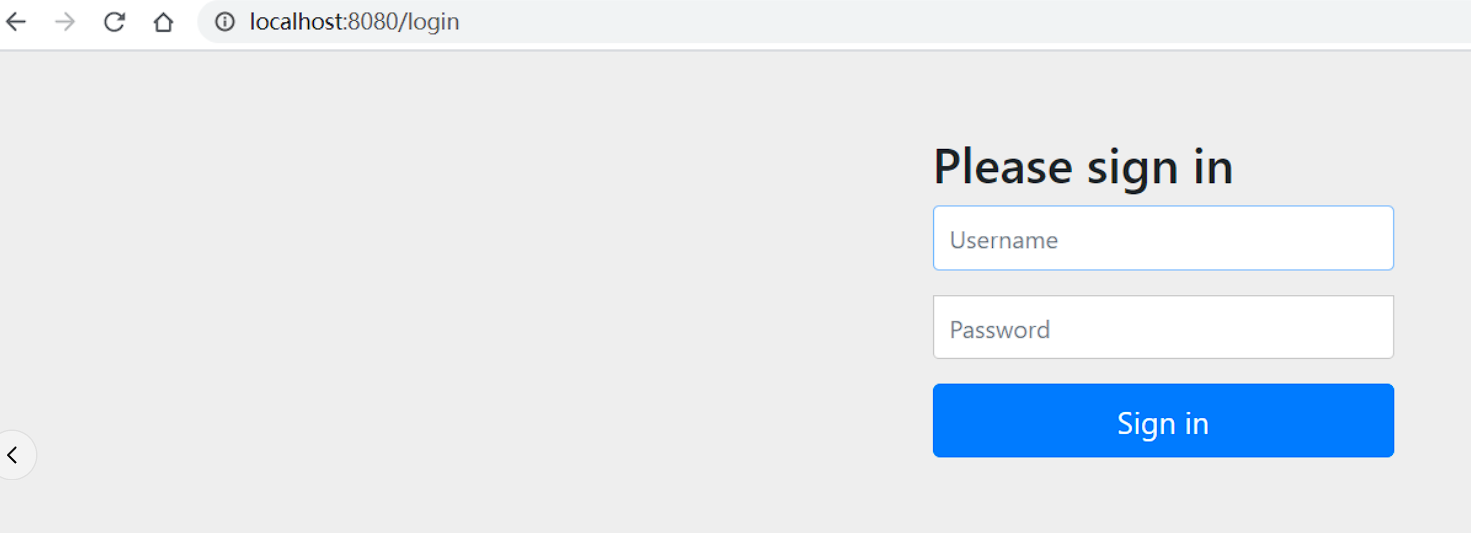
默认的用户名是
user,默认的登录密码 在每次启动项目时随机生成
从项目启动日志中可以看到默认的登录密码,登录成功后,就可以访问hello 接口了。
步骤4:自己配置账户名或者密码

步骤5:创建Spring Security配置类
创建一个继承自 WebSecurityConfigurerAdapter的配置类,并重写configure()方法来配置Spring Security的行为。@Configuration @EnableWebSecurity public class SecurityConfig extends WebSecurityConfigurerAdapter { @Override protected void configure(HttpSecurity http) throws Exception { http .authorizeRequests() //这开始了一个授权请求的配置链。.authorizeRequests() 方法允许你指定哪些 URL 需要认证和授权。 .antMatchers("/", "/home").permitAll() // 方法指定了两个 URL 模式,/ 和 /home。.permitAll() 表示这些 URL 可以被任何用户无条件访问,即使他们没有登录。 .anyRequest().authenticated() //.anyRequest() 表示所有未被前面规则明确指定的请求。.authenticated() 指定这些请求需要经过身份验证才能访问。 .and() //.and() 方法用于继续下一个配置步骤。在这里,它用于从授权请求配置切换到其他配置,如表单登录配置。 .formLogin() //.formLogin() 配置了表单登录功能 //.loginPage("/login") 指定了登录页面的 URL 注意:配置了.loginPage("/login") ,你必须写这个页面,如果不配置,就用Spring Security 内置的Form登录页面 .permitAll() // 表示这个登录页面可以被任何人访问,不需要身份验证。 .and() //同样地,.and() 用于继续到下一个配置步骤,这里是登出配置。 .logout() //.logout() 开始配置登出功能。 .logoutUrl("/logout") //设置了处理登出请求的 URL .logoutSuccessUrl("/login") //指定了登出成功后用户会被重定向到的 URL .invalidateHttpSession(true) //表示在登出时会销毁 HttpSession。 .deleteCookies("JSESSIONID"); //用于删除 JSESSIONID cookie,以完全清除用户的会话 } }
4.高级自定义配置
Spring Security抽象类 WebSecurityConfigAdapter—— 开发者通过继承它就能 得到Spring Security 默认的安全功能。 也可以通过覆盖它提供的方法来自定义自 的安全拦截方案。
WebSecurityConfigAdapter 中默认存在的方法:
/** *在此方法中,可以配置认证管理器(AuthenticationManager),包括定义用户、密码、角色等。例如,可以连接到数据库或LDAP来加载用户信*息,也可以配置内存中的用户数据等等. */ protected void configure(AuthenticationManagerBuilder auth ); /** *这个方法允许配置不受Spring Security过滤器链保护的资源,比如静态资源、视图解析器资源等。 */ public void configure(WebSecurity web) ; /** *configure(HttpSecurity http): 开发者通过重写这个方法来配置HTTP安全相关的所有细节。在这里,可以指定哪些URL需要身份验证、哪些 *可以匿名访问,还可以配置表单登录、HTTP基本认证、JWT认证等多种认证方式,以及自定义过滤器链、异常处理等 */ protected void configure(HttpSecurity http) throws Exception ;写自己的Security配置类
##记得加@EnableWebSecurity注解##@Configuration @EnableWebSecurity public class SecurityConfig extends WebSecurityConfigurerAdapter { /** * 从 Spring5 开始,强制要求密码要加密 * BCryptPasswordEncoder是Spring Security提供的一个密码加密工具类, * 它实现了PasswordEncoder接口,用于对用户的密码进行安全哈希加密存储,增强了系统的安全性。 */ @Bean PasswordEncoder passwordEncoder(){ return new BCryptPasswordEncoder(); } @Override protected void configure(AuthenticationManagerBuilder auth) throws Exception { auth.inMemoryAuthentication() //配置了两个用户,包括用户的用户名、角色、密码,用户密码已经加密(123) .withUser("zhangsan") //角色 .roles("BOSS") //密码已经加密,可以通过 passwordEncoder.encode("123")获取 .password("$2a$10$dQLFreAJHM0F.4XAWQMTA.kB5W3H2.hjA6xBUJFHTFT7iHRzO0flm") //连接方法 .and() .withUser("lisi") .roles("EMPLOYEE") .password("$2a$10$RDdoj3sm/RD7HzqSnU864eEE5kEZZxbyQqnYQJGrO2pgkUGCDutTC"); } }重启应用就可以通过zhangsan和lisi登陆了,虽然实现认证功能,但是受保护的资源都是一样的,只要登陆了,所有的接口都能访问。
但实际企业开发过程中我们要根据进行角色管理,如果要实现这些功能 就需要重写
WebSecurityConfigurerAdapter中的HttpSecurity方法:@Configuration @EnableWebSecurity public class SecurityConfig extends WebSecurityConfigurerAdapter { @Override protected void configure(HttpSecurity http) throws Exception { http.authorizeRequests() //开启登录配置 // 使用antMatchers 匹配请求路径 .antMatchers("/public/**").permitAll() // 允许所有人访问以 "/public/" 开头的资源 //访问以 "/boss/" 开头的资源需要 "boss" 角色 .antMatchers("/boss/**").hasRole("ROLE_boss") //访问以 "/employee/" 开头的资源,必须具备 boos、manager 的角色 .antMatchers("/employee/**").access("hasAnyRole('ROLE_boss','ROLE_manager')") // 访问以 "/api/" 开头的资源需要经过身份验证 .antMatchers("/api/**").authenticated() // 任何其他请求也需要经过身份验证 .anyRequest().authenticated() //开启表单登录 .and().formLogin(); } }书写接口验证
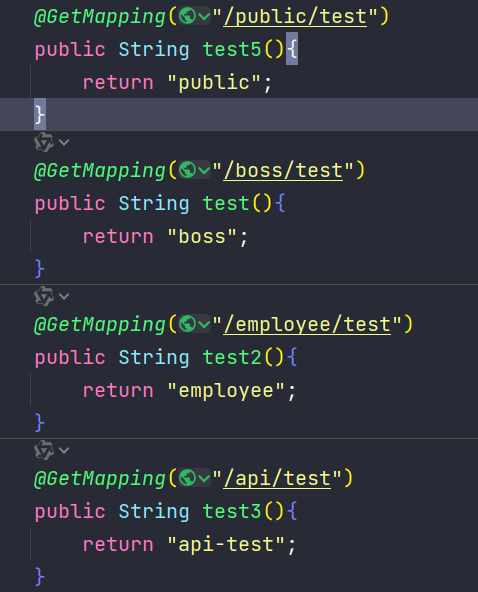
使用注解简化
上面介绍的认证与授权都是基于 URL 的,也可以通过注解来灵活地配置方法安全,要使用相关注解,首先要通过 @EnableGlobalMethodSecurity 注解开启基于注解的安全配置:@Configuration @EnableWebSecurity @EnableGlobalMethodSecurity(prePostEnabled=true,securedEnabled=true) public class SecurityConfig extends WebSecurityConfigurerAdapter { }(1) prePostEnabled=true
开启后会解锁 @PreAuthorize 和 @PostAuthorize 两个注解
- @PreAuthorize
会在执行方法前验证, 推荐使用 @PreAuthorize 因为支持Spring EL表达式@PreAuthorize("hasRole('ROLE_ADMIN') and hasRole('ROLE_USER')") //必须有全部的权限才可以访问 @PreAuthorize("hasRole('ROLE_ADMIN') or hasRole('ROLE_USER')") //至少有一个即可访问 @PreAuthorize("hasAnyRole('ROLE_ADMIN','ROLE_USER')") // 同上 - @PostAuthorize
会在执行方法后验证。
(2) securedEnabled=true
开启后会解锁 @Secured 注解,是基于角色的简单访问控制,Spring Security 3.x 之后不推荐。
判断是否具有角色,注意这里匹配的字符串需要添加前缀“ROLE_”@Secured({ "ROLE_admin", "ROLE_user" }) @Secured({"ROLE_admin"}) @GetMapping(value = "/test") public String testSecured() { return "testSecured"; }- @PreAuthorize
验证
得要把之前的 配置移除掉// .antMatchers("/bossapi/**").hasRole("boss") 都移除掉
5. Spring Security 结合 JWT使用
为什么要结合JWT使用?
Spring Security与JWT的结合在分布式系统、移动端和单页应用等场景下具备灵活性、可扩展性和安全性,因此被广泛应用于现代Web应用程序的身份验证和授权中。
JWT有不可替代的优势,但Security也有使用的便利性(已内置了很多权限验证功能),所以我们要结合一起使用,结合的时候,我们只使用Security鉴权功能,登陆功能不需要,因为我们已经自己实现了JWT相关的登陆接口,只是登陆成功后我们要把用户的角色Role写进token就可以了。
角色Role认证
默认情况下,
UsernamePasswordAuthenticationFilter处理的是 POST 请求到 /login 路径, 我们可以模仿UsernamePasswordAuthenticationFilter书写自己的过滤器@Configuration @EnableWebSecurity @EnableGlobalMethodSecurity(prePostEnabled = true,securedEnabled = false) // 开启注解 public class SecurityConfig extends WebSecurityConfigurerAdapter { @Override protected void configure(HttpSecurity http) throws Exception { http.csrf().disable(); http.logout().disable(); http.formLogin().disable(); http.sessionManagement().sessionCreationPolicy(SessionCreationPolicy.NEVER);// 禁用session http.authorizeRequests().anyRequest().authenticated();// 所有请求都需要认证 // 添加自定义的过滤器 http.addFilterBefore(new JwtTokenFilter(), UsernamePasswordAuthenticationFilter.class); // 配置HTTP安全模块的异常处理,指定未授权访问时的处理逻辑 http.exceptionHandling().authenticationEntryPoint((HttpServletRequest request, HttpServletResponse response, AuthenticationException authException)->{ response.setContentType("application/json;charset=utf-8"); response.getWriter().write("{\"code\":403,\"message\":\"未授权\"}"); }); } private class JwtTokenFilter extends BasicAuthenticationFilter { public JwtTokenFilter() throws Exception { super(authenticationManager()); } @Override protected void doFilterInternal(HttpServletRequest request, HttpServletResponse response, FilterChain chain) throws IOException, ServletException { // 从请求头中获取认证令牌 String token = request.getHeader("token"); // 初始化一个空的权限列表 List<GrantedAuthority> authorityList = new ArrayList<>(); // 如果令牌存在且不为空 if (ObjectUtil.isNotEmpty(token)) { // 解析令牌中的载荷信息 JSONObject jsonObject = JSONUtil.parseObj(JWTUtil.parseToken(token).getPayload().toString()); // 获取用户角色信息 JSONArray roles = jsonObject.getJSONArray("roles"); // 如果角色信息存在且不为空 if (ObjectUtil.isNotEmpty(roles)) { // 遍历角色信息,构建权限列表 for (Object role : roles) { SimpleGrantedAuthority authority = new SimpleGrantedAuthority(role.toString()); authorityList.add(authority); } } } // 创建认证对象,用于存放权限列表 UsernamePasswordAuthenticationToken authenticationToken = new UsernamePasswordAuthenticationToken("唯一", null, authorityList); // 将认证对象设置到当前的安全上下文中 SecurityContextHolder.getContext().setAuthentication(authenticationToken); // 继续执行过滤器链中的下一个过滤器 chain.doFilter(request, response); } } }
